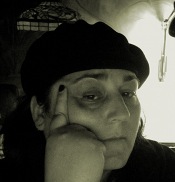I’m currently on vacation. Which, y’know, is pretty awesome. I spent a coupl’a days in do-nothing mode, sitting on my couch and watching movies. Which is about all that I’m capable of when work has drained me somewhat.
But now I’m in pet-project mode: I want to focus on something interesting. My pet project has been about going digital on the cartooning stuff. None of the instructors I’ve had have been terribly positive about computer-based art. Anthony (my primary instructor during my cartooning programme at George Brown) didn’t quite poo-poo digital art, but fundamentally believed that one had to learn how to draw using traditional tools before learning digital art. He also felt that most of the computer-produced art that he’d seen was very flat and lacked expressiveness.
Ty hasn’t taught us anything related to computers — he seems to draw and ink using traditional media, but he uses tools that Anthony would have turned his nose up at (markers! Pen brushes! Oh noes!) Ty also seemed to think that it was pointless to learn hand-lettering because nobody hand-letters these days. (I notice that Bechdel’s Are You My Mother? seems computer-lettered, whereas Fun Home looked hand-lettered). And Ty’s Bun Toons often include digital colouring and probably a bunch of other computer tweaks. So he seems more pragmatic about the use of computers than Anthony ever did.
For my part, I’ve always found soft-copies of things easier than working with paper. I can write using a keyboard far faster than I can write using a pen. (The only part of the book, Writing Down the Bones that really spoke to me was the part about finding the right pen — to this day, I’m picky and anal about the types of pens I use. But I’d still much rather use a keyboard). So it seems like a bit of a no-brainer that I’d want to adapt to using digital drawing methods. And I don’t know why I just suddenly got the bug to start adapting now, but I do find myself wanting to invest some time at it.
Scott McCloud says, in Making Comics, that he’s been putting books together completely digitally for ten years (and that book’s 6 years old, now). That’s always stuck out for me. McCloud admits that he hand-draws full thumbnail breakdowns and then scans those as the first step in his process. But after that, it’s all digital, all the time.
In contrast, take a look at these videos, in which DC artist Freddie E. Williams II draws Batman digitally. As Williams says, in The DC Comics Guide to Digitally Drawing Comics, he starts with digital thumbnails.
(These are from a two part article from The Comics Journal).
So, this vacation, I decided to start learning digital art. (There’s a Digital Painting and a Digital Illustration class at George Brown. I’m tempted.)
My cool friend, ![]() sabotabby, let me try her Wacom tablet — I was so awful! But! I can only get better!
sabotabby, let me try her Wacom tablet — I was so awful! But! I can only get better!
(I found it really refreshing to see how sketchy Williams is for the first passes. It makes me feel a lot better about how hard it was to get good with a tablet).
So I bought a tablet, and it arrived last night. Here it is:
It’s an Intuos 5 tablet, medium-sized. I’ve had it for less than a day, and I’m already keen to get the wireless add-on: the cable is annoying.
Here’s my absolute first drawing with it. Notice how bad it is — it’s awesomely bad! But I’m putting it out there as an interesting reference to chart my progress against it.
The Intuos logo was made by tracing over a logo from the “set-up” book. I was playing with a trial version of Corel, which is a tool I don’t really know, but which mostly works similar to Gimp and other drawing tools.
I still have a bunch of things I need to get better at. I think I can do a good job with panel arrangement and pacing. I feel like I got pretty good with inking. And I’m not-bad when I’m drawing from reference. But I think I need to do a lot more work with anatomy, which I kinda suck at. And I’d like to be better at perspective; I’m okay with basic one- and two-point perspective, especially with things like buildings, but I’d like to get better at drawing people in perspective, and things like panel layouts from high or low “camera” angles. To some extent, it’s weird to complicate the learning process by throwing digital art into the mix, but heck, I’m gonna complicate it.



I’m finding it really interesting what people are doing with drawing comics digitally that is breaking away from the traditional comics style — the linocut vibe of Digger by Ursula Vernon, or crazy flat color of Egypt Urnash’s Decrypting Rita. (Of course, I’m really sucking at learning how to draw traditional realistic figures, so that might be part of the appeal, because at some point I need to stop spending *all* my comic time on practicing drawing and really start actually making comics.)